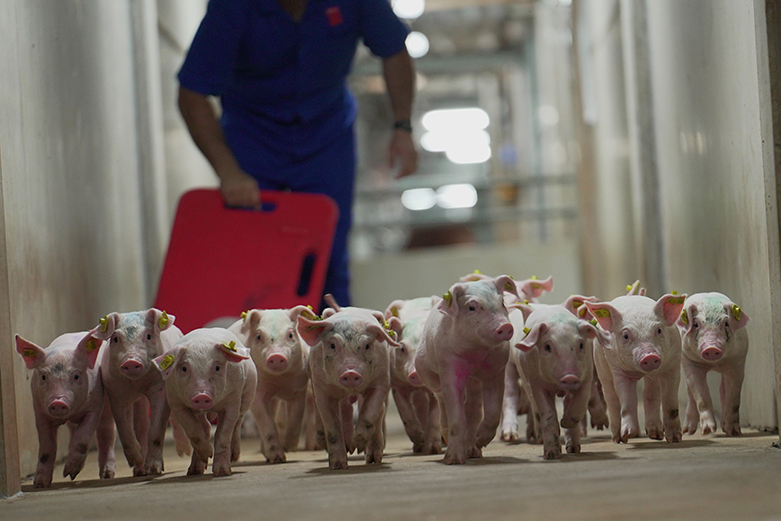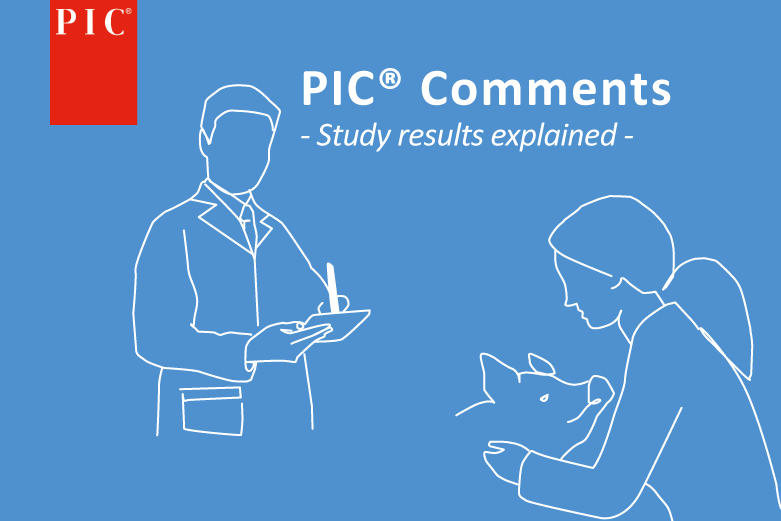“Sustainability” is a term that everyone is talking about these days. But what about the practical implementation in everyday pig production? Here it is important to produce in a more resource-efficient way and with more animal welfare. We have put together 4 tips that you can implement directly on your farm.
- Know the weight of your gilts when they are served for the first time.
The body weight of gilts is an important factor for their subsequent longevity, especially for sows in the first two production cycles.
The optimal body weight for first serving is 135-160 kg. Often sow owners estimate weight visually, but most underestimate it. The most accurate estimate is obtained by using a flank tape (e.g., the PIC flank tape – Contact PIC).
If your gilts are too heavy (i.e., over 160 kg), you risk more failures due to lameness. The negative effects of too heavy animals together with poor floor quality can be exacerbated by rank fights when the animals are housed together.

If you have to serve (too) heavy gilts, you should mark them and observe them closely during pregnancy and subsequent farrowing. This will help you to identify possible problems early on and take appropriate measures, such as adjusting the daily feed quantity. Furthermore, the targeted promotion of feed intake during lactation can lead to a higher retention rate. Ensure more animal welfare …
A young sow that starts her production life (too) heavy has a higher maintenance requirement for feed throughout her life. Save your resources …
- Carry out regular condition assessments
The body condition of sows is usually assessed based on a subjective evaluation, with an increasing risk of over- or underfeeding during pregnancy. Pig farmers with low sow losses know that body condition is important. They have implemented a uniform and objective evaluation system for body condition on their farms.
The Caliper is an ideally suited tool for this. As the application is simple and objective, the condition assessment can be carried out by different people. Condition assessment should be carried out at least at farrowing and weaning. For best results, it is recommended that the measurement is taken at four weeks along with the pregnancy check and repeated on the 90th day of gestation.

Over-conditioning simply costs money: In addition to direct feed costs, you experience reduced performance due to reduced feed intake in the suckling period, poorer restocking, foundation problems, etc.
Feed costs account for 60% of direct costs in piglet production, about 30% for sow feed. Just 100 g gestation feed per day more per sow means additional costs of about £4,500 for a farm with 500 sows (feed prices 2022). Feeding 250 g more than required per day means more than £10,800. Save your resources …
- Select your older sows according to fixed criteria

Certainly, the goal of keeping the size of the sow groups consistent comes before the consistent and targeted selection of the older sows. This means that good planning is the be-all and end-all for both, producers with a Closed herd multiplication to produce the replacement gilts themselves and producers who purchase gilts. Closed herd farmers must plan the allocation of sows for damline matings at an early stage. When buying-in gilts, it is advisable to coordinate annual planning with the supplier in good time. If there are enough gilts available, they can be selected consistently according to performance.
An important prerequisite is to have as few involuntary departures of sows if possible before the fourth litter. This includes, for example, leg and feet problems, physical weakness, mammary deficiencies or even deaths or euthanasia – in other words, all reasons that have nothing to do with age or performance. Save your resources …
- Increase the productivity of your herd.
For long-term successful production, it is important to secure and continuously increase the productivity of your herd, of course without neglecting the previously discussed points.
Keep an eye on the age structure of your herd and make sure that you have no less than 20% gilts in the herd, see Fig. 1, because with the gilts you bring breeding progress into your herd. With the targeted selection of the older sows for weaning according to performance and age, you create space for the next generation, which allows you to participate in the latest breeding developments. With the optimal herd structure, you have a good balance between longevity and productivity. Remember that 1 to 1.5 more litters per sow lifetime also means that you miss out on between 40 and 65% of the annual breeding progress. This means at least 0.5 more weaned piglets/ sow/year, and depending on the re-mating rate and litter sequence, 1 piglet per sow and year (based on PIC breeding progress).

Benefit from genetic improvement
Breeding progress is the keyword. This is about the responsibility of your genetics supplier, who has a not inconsiderable and important role to play. And this for two reasons: on the one hand, because the breeding products are at the beginning of every production chain, i.e., they determine the performance potential. Secondly, because breeding decisions are (or must be) made several years in advance to have the right genetics on the market at the right time.
Camborough®
With the latest generation of Camborough, PIC provides you with the basis for successful piglet production, because it has the prerequisites to make the most of the previous recommendations.
The Camborough® has always stood for superior profitability because successful pig production equals efficient pig production.
The Camborough®
- significantly reduces feed costs to ca. 1,200 kg/sow per year (28 lactation days)
- delivers litters with 15 and more born alive robust piglets
- delivers vital piglets with very good birth weights and thus saves additional efforts
- raises her piglets herself and thus saves on piglet milk or technical equipment
- comes into heat quickly and thus saves unproductive days
- is easy to manage and thus saves labour
- is proven to be strong on legs and feet and durable


More about the robustness update


With the latest generation Camborough® you bring sustainability into the barn by more efficiency, more robustness, and more productivity.




